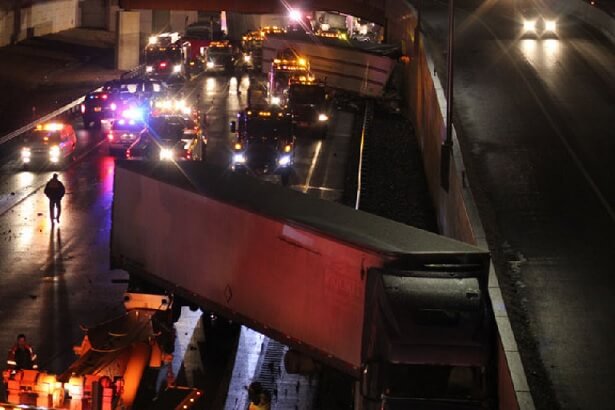Turnpike turned deadly in an instant on night of chain reaction crash, state report details
Submitted by New Jersey truck crash lawyer, Jeffrey Hark.

That crash was followed quickly by several other accidents.
Crosby’s account of what happened on the night of Feb. 9, when one driver was killed and 61 other injured in a series of chain reaction accidents on the Turnpike in Cranbury, matches the account of 35 turnpike authority workers and state troopers.
They tell the story of a band of precipitation that quickly turned the dry highway into a dangerously ice-slicked road, causing spin-outs and collisions.
The accounts are part of a report ordered by Transportation Commissioner Jamie Fox that was conducted by the Turnpike Authority and obtained by NJ Advance Media.
The report found the authority did nothing wrong in how it treated the highway that night.
From supervisors to state troopers, the story of what happened around 9 p.m. on Feb. 9 is the same — a dry highway that suddenly turned icy and wild.
When Christopher Cook began driving his plow southbound to start salting, the highway was dry and traffic was passing him at a high rate of speed.
Shortly after he received a radio call from Supervisor Dean Appleby warning that conditions had turned icy, the roadway turned “wet and slippery” and several accidents occurred in front of him, Cook told investigators.
How fast did it happen?
Molly Pitcher service area employees told investigators that rain that began falling at 9 p.m. turned to ice as soon as it hit the pavement.
Appleby, a district foreman who had been checking pavement temperature and testing road slickness, saw a vehicle spin out on the northbound turnpike at milepost 71. At 9:03 p.m., he instructed salt trucks, which had been standing by in various locations on the Turnpike, to start an all-hands-on-deck “full salt operation” and had the speed limit dropped to 45 mph.
But it was too late. Appleby, who had parked on an overpass near the service area, told investigators that conditions “deteriorated rapidly and an extreme icing condition occurred.” The first accident was reported at 9:04 p.m., and Appleby said he saw the major chain reaction crash from the overpass.
Numerous drivers called to report crashes and spinouts. State police had the speed limit dropped to 35 mph. Eight callers reported they were involved in accidents between south of Exit 10 and Cranbury. Other drivers called to report accidents. One woman called to report she climbed out of a window of a bus that crashed.
The first crash occurred on the southbound outer roadway when two, two-vehicle collisions occurred, followed by a crash involving two tractor-trailers. State police said a total of 19 vehicles were involved in the outer or truck lanes. The outer roadway crashes included the collision that claimed the life of Darryl C. Williams, 52, of Bordentown.
The crash on the southbound inner roadway followed a similar pattern, starting with a two vehicle crash which led to a series of secondary crashes, the report said.
What happened and why?
Weather forecasters hired by the turnpike authority blamed “a period of heavier precipitation in the vicinity of Cranbury between 9 and 10 p.m.” TELVENT DTN LLC, which provides weather forecasting services and post storm reviews to the authority, said the rain hit the subfreezing pavement and began a cycle of melting and re-freezing “almost instantaneously on the pavement.”
The air temperature was 27 degrees and the pavement temperature had been recorded at 28 degrees in the area. Vehicles traveling in that area may not have been riding on the pavement, but on a thin layer of ice instead that was above the pavement, the forecaster said in the report.
While the general forecast for the night of Feb. 9 warned of a “chance of freezing rain after 5 p.m.,” the report said there were no special advisories, warnings or forecasts about the sudden precipitation that hit the turnpike.
State Police Sgt. Edward Kriso told investigators that the road was “ice covered” when he arrived at the accident site and he requested salt trucks to treat the scene because first responders were slipping.
“It was a very dangerous condition for them to be working in,” he said in the report.
What’s next?
The report found no fault with the authority’s salting operations that night. What it did recommend was that the authority install Road Weather Information Systems, including ice detectors at “appropriate locations” to monitor weather and road conditions. Those systems are supposed to provide information to highway decision makers.
“The Turnpike Authority staff is evaluating the recommendations in the report,” said Tom Feeney, a turnpike authority spokesman. “Decisions about how to go forward with RWIS, including decisions on what the system will look like and when it might be installed, will be made during that process.”
Originally published here.
Larry Higgs may be reached at lhiggs@njadvancemedia.com. Follow him on Twitter @commutinglarry. Find NJ.com on Facebook.
